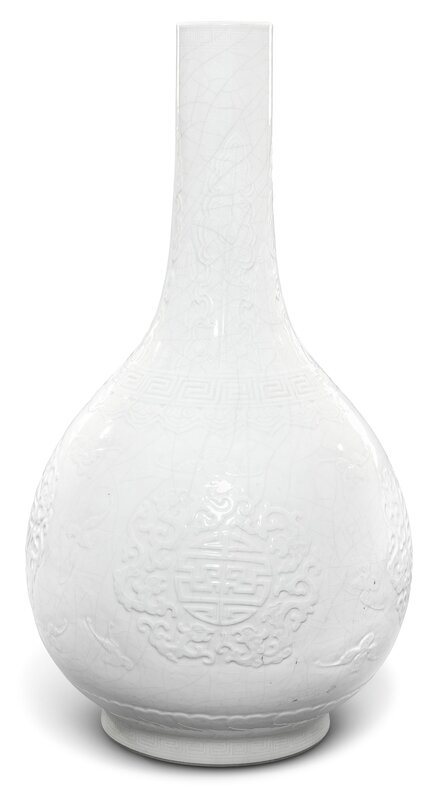A fine large relief-decorated 'Bat and Shou' bottle vase, seal mark and period of Qianlong (1736-1795)
Lot 3639. A fine large relief-decorated 'Bat and Shou' bottle vase, seal mark and period of Qianlong (1736-1795); 39.2 cm, 15 3/8 in. Estimate 800,000 — 1,200,000 HKD (101,912 - 152,868 USD). Unsold. Courtesy Sotheby's.
the pear-shaped body rising from a straight foot to a tall cylindrical neck, finely moulded to the exterior with four stylised shou character medallions, each encircled by five archaistic kui dragons, interspersed with flying bats in various orientations, above a band of wavy lappets, the shoulder and neck encircled by stiff plantain leaves, key-fret and ruyi bands, bordered by further key-fret bands at the rim and foot, covered overall in a transparent glaze pooling at the recesses, the base inscribed with a six-character seal mark in underglaze blue.
Provenance: Hong Kong Associated Auctioneers, 1990s, by repute.
Note: risply carved with an auspicious design of four shou character medallions, each surrounded by five archaistic kui dragons and bats hovering between them, this vase belongs to a distinct group of carved porcelain wares of the Qianlong reign. During the Qing dynasty, three types of white wares are recorded to have been produced: the traditional high-fired wares with a transparent glaze, first created during the Yongle reign of the Ming dynasty, which formed the majority of white wares; soft-paste type wares which were characterised by a yellowish-ivory tinge; and Ding-type wares, which were fired at a higher temperature than the original (see the catalogue to the exhibition Qing Imperial Monochromes. The Zande Lou Collection, Hong Kong, 2005, p. 82). According to the archival records, while some Ding-type wares produced duplicated the colour, form and size of certain Ding wares of the Song dynasty, others only borrowed aspects of their predecessors (ibid, p. 80). In creating these Ding-type wares, huashi replaced kaolin, allowing the vessel to be fired at a lower temperature to avoid warping of the material and to create a white glaze that could be used for both objects imitating Ding wares as well as contemporary design, such as the present piece.
Vases belonging to this Ding-type group were produced in various forms and designs and were more commonly produced with an impressed or incised reign mark; vases with impressed marks include a pear-shape vase with flared neck, carved with foliate lotus flowers, from the collection of Robert Chang, sold in our London rooms, 10th December 1991, lot 280, again at Christie’s Hong Kong, 2nd November 1999, lot 528, and a third time in our London rooms, 8th November 2017, lot 17; one of baluster form, modelled with four handles at the shoulders and decorated with a flower scroll, published in The Complete Collection of Treasures of the Palace Museum. Monochrome Porcelain, Hong Kong, 1999, pl. 239; and a pomegranate-form vase carved with a scrolling lotus and bat design, in the National Palace Museum, Taipei, included in the Museum’s exhibition Qingdai danse you ciqi tezhan [Special exhibition of monochrome glazed porcelain of the Qing dynasty], Taipei, 1981, cat. no. 64. Vases with incised marks include a baluster vase with two deer head-shaped handles and carved on the body with cranes amongst clouds, from the collection of Dr Joseph and Donna Lee Boggs, sold in our London rooms, 7th November 2012, lot 110; another depicting a lotus pond with egrets, sold at Christie’s Hong Kong, 28th November 2012, lot 2129; an archaistic hu vase carved with two confronting phoenixes, included in the exhibition Monochrome Ceramics of Ming and Ch’ing Dynasties, Hong Kong Museum of Art, Hong Kong, 1977, cat. no. 141; and a bottle vase decorated with a dragons striding amongst flames and waves, sold in these rooms, 3rd October 2017, lot 3603.

An important and rare relief-carved white-glazed 'lotus' vase, Qianlong seal mark and period (1736-1795), 34.2 cm, 13 1/2 in. Sold for 489,000 GBP at Sothebys London, 8th November 2017, lot 17. © Sotheby's.
Cf. my post: An important and rare relief-carved white-glazed 'lotus' vase, Qianlong seal mark and period (1736-1795)

From the collection of Dr Joseph and Donna Lee Boggs. A Rare White-Glazed Relief-Carved Vase, Qianlong Seal Mark and Period; 29.6cm., 11 5/8 in. Sold for 193,250 GBP at Sotheby's London, 7th November 2012, lot 110. Photo Sotheby's
Cf. my post: A Rare White-Glazed Relief-Carved Vase, Qianlong Seal Mark and Period

A rare relief-decorated white-glazed baluster vase, Qianlong incised six-character seal mark and of the period (1736-1795), 8 1/16 in. (20.5 cm.) high, stand. Sold for HKD 1,940,000 at Christie’s Hong Kong, 28th November 2012, lot 2129. © Christie's Images Ltd 2012

A rare relief-carved white-glazed 'Dragon' bottle vase, seal mark and period of Qianlong (1736-1795), 28.7 cm, 11 1/4 in. Sold for 2,000,000 HKD at Sotheby's Hong Kong, 3rd October 2017, lot 3603. Photo Sotheby's.
Cf. my post: A rare relief-carved white-glazed 'Dragon' bottle vase, seal mark and period of Qianlong
A slightly smaller soft paste vase of this design, but without a reign mark, was sold in our New York rooms, 31st March/3rd April 2005, lot 129, and again in our London rooms, 10th November 2017, lot 223.

A white-glazed soft-paste vase, Qing dynasty, Yongzheng period (1723-1735); 38.2 cm, 15 in. Sold for 30,000 GBP at Sotheby's London, 10th November 2017, lot 223. Courtesy Sotheby's.
Cf. my post: A white-glazed soft-paste vase, Qing dynasty, Yongzheng period (1723-1735)
Sotheby's. Important Chinese Art, Hong Kong, 03 oct. 2018, 03:00 PM

/https%3A%2F%2Fprofilepics.canalblog.com%2Fprofilepics%2F1%2F0%2F100183.jpg)
/https%3A%2F%2Fstorage.canalblog.com%2F03%2F02%2F119589%2F96711876_o.jpg)
/https%3A%2F%2Fstorage.canalblog.com%2F11%2F31%2F119589%2F94773502_o.jpg)
/https%3A%2F%2Fstorage.canalblog.com%2F20%2F83%2F119589%2F94772815_o.jpg)
/https%3A%2F%2Fstorage.canalblog.com%2F26%2F72%2F119589%2F75604929_o.jpg)
/https%3A%2F%2Fstorage.canalblog.com%2F59%2F60%2F119589%2F26458628_o.jpg)




/image%2F1371349%2F20240402%2Fob_9318b6_130-1.jpg)
/image%2F1371349%2F20240402%2Fob_7227e1_129-1.jpg)
/image%2F1371349%2F20240402%2Fob_e7099e_128-1.jpg)
/image%2F1371349%2F20240401%2Fob_834d8f_telechargement.jpg)